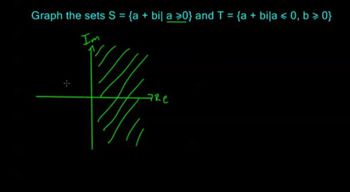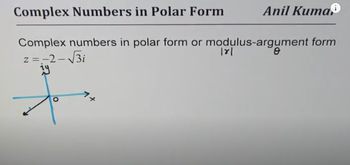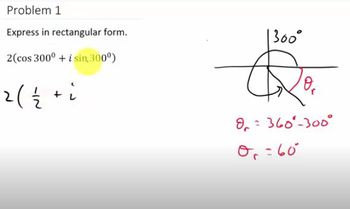Table of contents
- 0. Review of College Algebra4h 43m
- 1. Measuring Angles39m
- 2. Trigonometric Functions on Right Triangles2h 5m
- 3. Unit Circle1h 19m
- 4. Graphing Trigonometric Functions1h 19m
- 5. Inverse Trigonometric Functions and Basic Trigonometric Equations1h 41m
- 6. Trigonometric Identities and More Equations2h 34m
- 7. Non-Right Triangles1h 38m
- 8. Vectors2h 25m
- 9. Polar Equations2h 5m
- 10. Parametric Equations1h 6m
- 11. Graphing Complex Numbers1h 7m
11. Graphing Complex Numbers
Polar Form of Complex Numbers
Problem 15b
Textbook Question
Textbook QuestionIn Exercises 15–18, write each complex number in rectangular form. If necessary, round to the nearest tenth. 8(cos 60° + i sin 60°)
 Verified Solution
Verified SolutionThis video solution was recommended by our tutors as helpful for the problem above
Video duration:
2mPlay a video:
Was this helpful?
Key Concepts
Here are the essential concepts you must grasp in order to answer the question correctly.
Complex Numbers
Complex numbers are numbers that have a real part and an imaginary part, typically expressed in the form a + bi, where a is the real part and b is the coefficient of the imaginary unit i. In trigonometric form, a complex number can be represented as r(cos θ + i sin θ), where r is the magnitude and θ is the angle. Understanding how to convert between these forms is essential for solving problems involving complex numbers.
Recommended video:

Dividing Complex Numbers
Polar to Rectangular Conversion
The conversion from polar to rectangular form involves using the relationships x = r cos θ and y = r sin θ, where (x, y) are the rectangular coordinates. This process allows us to express a complex number in the standard form a + bi. For the given complex number, substituting the values of r and θ will yield the rectangular coordinates necessary for the solution.
Recommended video:

Convert Points from Polar to Rectangular
Trigonometric Values
Trigonometric values such as cos(θ) and sin(θ) are fundamental in determining the components of a complex number in polar form. For example, cos(60°) equals 0.5 and sin(60°) equals √3/2. Knowing these values is crucial for accurately converting the complex number from its trigonometric representation to rectangular form.
Recommended video:

Fundamental Trigonometric Identities

 4:47m
4:47mWatch next
Master Complex Numbers In Polar Form with a bite sized video explanation from Nick Kaneko
Start learningRelated Videos
Related Practice














